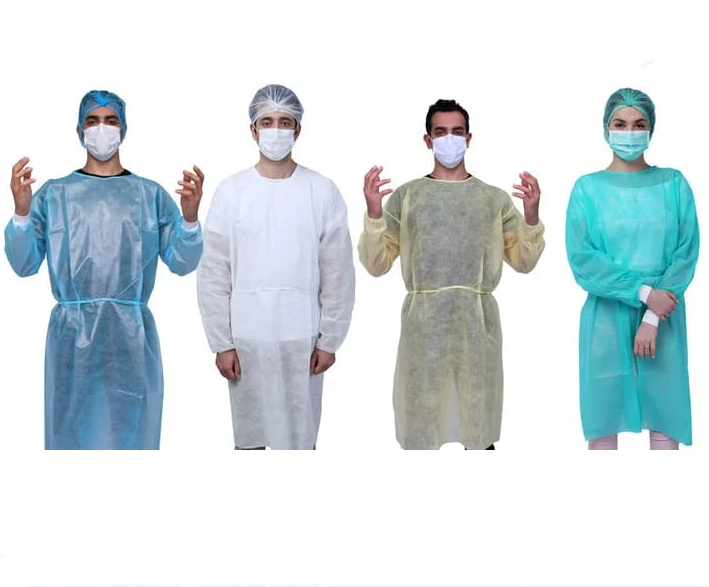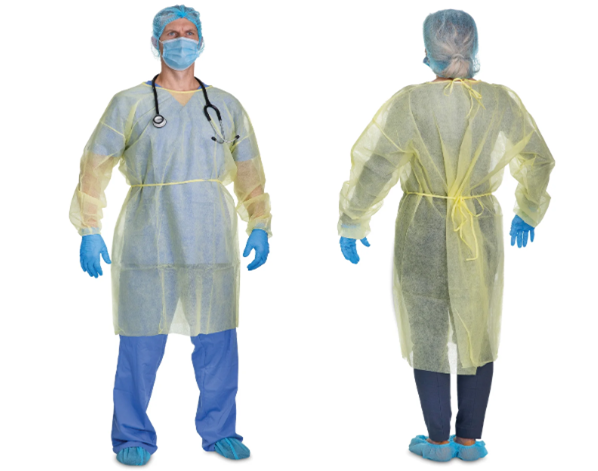Isolation Gowns

Isolation gowns are personal protective equipment (PPE) worn by healthcare workers to provide a barrier against microorganisms, body fluids, and other contaminants, preventing their spread between patients and staff, or within a healthcare environment. They protect the wearer's clothing and skin by covering the torso and arms, are available in disposable or reusable forms, and must be selected based on the risk of exposure to infectious materials.
Purpose of Isolation Gowns
Prevent Infection Transmission:
They act as a physical barrier to stop microorganisms and potentially infectious fluids from reaching the wearer's clothing and skin.
Protect the Patient:
By preventing contamination of the healthcare worker's personal clothing, isolation gowns help prevent the transfer of microorganisms from one patient to another.
Maintain Hygiene:
They are crucial for maintaining a safe and hygienic environment in healthcare settings, especially during infectious disease outbreaks.
Key Features
Coverage:
Gowns are designed to fully cover the torso, with arms extending to the wrists, and should wrap around the back to provide complete protection.
Materials:
They are made from various fabrics, such as nonwoven materials like polypropylene for disposable gowns or cotton and polyester blends for reusable gowns.
Closure:
Gowns often feature waist ties to secure the gown in place, elastic cuffs for a snug fit, and a full back or breakaway feature for easy removal.
Types of Gowns
Non-Surgical (Isolation) Gowns:
Used in low-risk patient isolation situations to prevent the transfer of microorganisms and body fluids.
Surgical Gowns:
A different type of garment, intended for use during surgical procedures, offering a higher level of barrier protection and meeting specific sterility requirements.
Selecting the Right Gown
The type and material of the isolation gown should be chosen based on the specific clinical task and the potential risk of exposure to body fluids or contaminants.
Gowns are rated using standards like AAMI levels, which indicate their barrier performance against fluids and are essential for selecting the appropriate gown for different situations.

Selecting the Best Isolation Gowns for Public and Private ...To choose isolation gowns, consider the ANSI/AAMI protection level (Level 1-4) based on potential exposure, evaluate the material for barrier properties and breathability (e.g., SMS for a balance of comfort and resistance), assess the fit and comfort features like elastic cuffs for secure wear, decide between disposable or reusable options based on cost and environmental factors, and confirm compliance with regulatory standards.
1. Assess the Level of Protection
ANSI/AAMI Protection Levels:
Gowns are categorized into four levels based on the risk of exposure to bodily fluids and contaminants.
Level 1: Minimal risk (e.g., basic care, standard environments).
Level 2: Light risk (e.g., routine patient care, clean situations).
Level 3: Moderate risk (e.g., procedures with moderate fluid exposure).
Level 4: High risk (e.g., high-risk surgeries, protection against infectious agents).
2. Evaluate the Material
Barrier Performance:
Look for materials with high fluid resistance and effective barrier properties.
Breathability:
Materials like SMS (spunbond-meltblown-spunbond) balance liquid resistance with breathability for comfort during use.
Synthetic Materials:
Synthetic materials are generally better at blocking fluids than cotton and are often preferred for healthcare settings.
3. Consider Comfort and Fit
Secure Fit:
Gowns should fit well to ensure comfort and prevent exposure to contaminants.
Secure Closures:
Features like elastic or knit cuffs and thumb loops help keep sleeves in place and provide a secure fit.
Breathability:
Gowns should be breathable to prevent overheating and sweating, which can compromise wearer comfort and protection.
4. Choose Between Disposable and Reusable
Disposable Gowns:
Convenient for single use, eliminate laundering needs, and reduce the risk of cross-contamination.
Reusable Gowns:
More durable and can be laundered and reused multiple times, potentially offering cost savings and environmental benefits.
5. Check for Compliance and Certification
Regulatory Standards:
Ensure that isolation gowns meet FDA approval and comply with relevant ANSI/AAMI standards for safety and quality.
Supplier Reliability:
Choose gowns from reputable suppliers who provide documentation that the products meet performance standards.

 Send Email
Send Email